Since their start in Houston in 1994, KIPP (Knowledge Is Power Program) charter schools have been the most celebrated of the No Excuses schools. Employing strict discipline, an extended school day and year, and carefully selected teachers, No Excuses schools move disadvantaged students who start behind their peers academically up to and above grade level in reading and math, and on the path to success in college. Studies conducted by Mathematica Policy Research show that KIPP schools achieve significantly greater gains in student achievement than do traditional public schools teaching similar students. Recent large-scale research at Stanford University’s Center for Research on Education Outcomes (CREDO) also finds that KIPP teaching is highly effective, with individual students learning far more than their statistical “twins” at traditional public schools. KIPP’s own studies find that the schools substantially increase the odds that a disadvantaged student will enter and graduate from college. Not surprisingly, the 144 KIPP charter schools across the nation have no shortage of fans, including President Barack Obama, Microsoft founder Bill Gates, and Secretary of Education Arne Duncan.
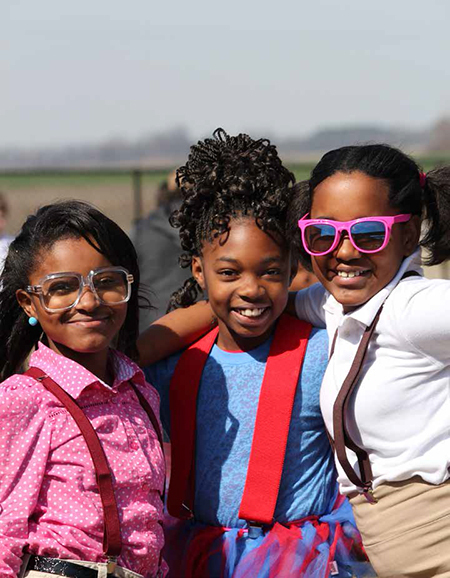
Also not surprisingly, KIPP and other No Excuses schools have no shortage of critics. Furman University education professor P. L. Thomas, who admitted in a recent speech at the University of Arkansas to never having been in a No Excuses charter school, complains in a widely referenced 2012 Daily Kos post that in such schools, “Students are required to use complete sentences at all times, and call female teachers ‘Miss’—with the threat of disciplinary action taken if students fail to comply.” Regarding KIPP in particular, Cambridge College professor and blogger Jim Horn, who admits to having never been inside a KIPP school, nonetheless has referred to KIPP as a “New Age eugenics intervention at best,” destroying students’ cultures, and a “concentration camp” at worst.
Such criticisms could be dismissed if held on the margins of American public education. Unfortunately, within many education schools and teachers unions, KIPP detractors are more prevalent than KIPP backers. All too many professors and education administrators think that KIPP, and schools like it, succeed by working their students like dogs. Like all charter schools, KIPP schools are chosen by parents, but critics fear that disadvantaged parents do not know enough to choose wisely, or else do not have their children’s best interest at heart. Leaving aside whether the critics patronize the people of color KIPP schools serve, we propose that KIPP and similar schools are not nearly as militaristic as critics, who may have never been inside them, fear.
Inside a KIPP School
We have done hundreds of hours of fieldwork over the past eight years in 12 KIPP schools in five states, interviewing scores of teachers, students, and administrators. It is true that an atmosphere of order generally prevails. We found that schools that begin by establishing a culture of strict discipline, in neighborhoods where violence and disorder are widespread, ease off once a safe, tolerant learning environment is secured. “KIPPsters” and their teachers live up to the Work Hard, Be Nice motto but also play hard when the work is done. A schoolwide focus on academics is palpable. The schools nonetheless make time for band, basketball, chess, prom, and any number of clubs.
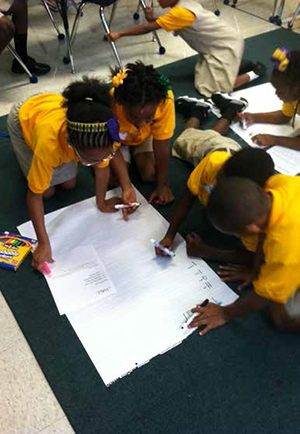
Student interactions are atypical. The KIPP schools we observed emphasize teamwork and assuring success for all (“team beats individual”; “all will learn“), encouraging more-advanced students to help their peers rather than just fend for themselves, in contrast to more individualistic traditional public schools.
Teachers in KIPP schools have to be willing to go the extra mile. We demonstrate in a forthcoming Social Science Quarterly article that in advertisements for teaching positions, KIPP schools consistently emphasize public service incentives, serving kids, while nearby traditional public schools emphasize private incentives, namely salary and benefits. One principal explained that KIPP’s New Orleans region hires teachers, in part, for “the J factor—Joy—enthusiasm and joy in learning, how to make learning fun; you were just in that classroom and could see that teacher had joy in the way he was leading the class.” If teachers don’t have it, then they probably can’t succeed at KIPP.
At KIPP McDonogh 15, a combined elementary and middle-school building in New Orleans’s French Quarter, the middle-school principal played music, and students and staff danced down the hallways as they moved from one class session to another. In the elementary school a floor below, some teachers took this concept a step further, using a lively musical transition from one lesson to another. Like most KIPP teachers elsewhere, teachers here constantly judge students, but their pronouncements are more positive than negative, as in, “I like how you stopped working as soon as I asked you,” and “I’ll shout out to you for helping your neighbor with that problem.”
Out of earshot of teachers, we talked with five elementary students. Though one boy said, “I liked my old school better; it was easier,” his peers preferred KIPP. Another boy said of his old school, “I was learning badly. Now I’m learning better.” One boy, who had been afraid in his old school, said, “I didn’t have any friends, and now I have lots of friends.” All the students we spoke to liked their KIPP teachers, teachers like Garrett Dorfman, a bespectacled 20-something in a #9 Drew Brees jersey, who looks older than his years but really comes alive in front of his 3rd graders. Although he originally planned to teach for just a few years, Dorfman is now hooked for life on New Orleans and on teaching at KIPP.
After finishing an engaging lesson in which students competed to see who could answer math questions the fastest, Dorfman called on one of us to answer his students’ questions about college, where they would all be in just 10 years. The students asked good questions about how to choose a college, how to pick a major, and the advantages of commuting as opposed to living on campus, until one student asked if most colleges did “celebration.” When asked what celebration is, the 3rd grader said we would have to stay after lunch, and then we could see. Dorfman ended class with a pep talk about the upcoming standardized tests:
I have this tough homework for you. Play with your friends. Get a good night’s sleep. I do have these 450 homework problems for you. [Class answers NO!]
Would you believe 450 pages’ worth? [Class answers NO!]
OK, the main thing is to come here next week on time at 7:40 sharp, because they won’t let you start the test late, with your game face on. Let’s see your game face. [They roar and he roars back.]
Remember that you can call me over the weekend if you need to. Now four shoutouts and go downstairs to celebration!
School Spirit, KIPP-Style
At celebration, held at McDonogh 15 most Friday afternoons, students played games devised by staff for a half hour, after which students who had no behavioral issues and who had won the lottery could hit any teacher or leader they chose with a pie. (Not coincidentally, Friday is casual-dress day at the school.) One mile away and four days later, a professor at the AERA (American Educational Research Association) annual conference denounced KIPP as a “concentration camp,” but to those of us who have been there, KIPP McDonogh 15 is about as far from a concentration camp as you can get.
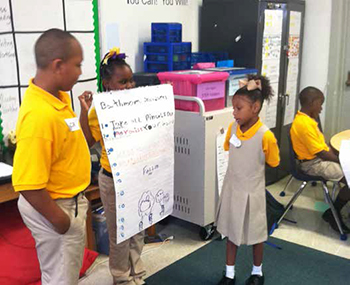
Not all KIPP schools manage the school day in exactly the same way. On a day-to-day basis, the KIPP Delta schools in Arkansas are a little stricter than the KIPP schools in New Orleans: the network varies across communities more than critics or supporters realize. But even at KIPP Delta, teachers may not survive the day without getting a pie to the face. We spent two days observing at KIPP Blytheville College Preparatory School (BCPS) in Blytheville, Arkansas, in March 2013 during Geek Week. Each March at KIPP BCPS, students participate in a week of activities similar to Spirit Week in traditional public schools. Geek Week included Pattern Day, where students mismatched different patterns on their clothing; Superhero Day, where students dressed as their favorite superhero; and Geriatric Day, where students dressed like the elderly. The festivities culminated with Pi Day, on March 14 (3.14). On Pi Day, students were given an information sheet about the number pi, noting its history and function in mathematics. The sheet included a mirror image of the number 3.14, which looked like the letters P, I, and E.
A general air of excitement preceded the Pi Challenge, in which students competed to see who could recite the most digits of pi, followed by the chance to hit a teacher with a pie. Student surveys picked the three “meanest” teachers in the school to “pie,” along with school director Maisie Wright, and they in turn got to honor, or dishonor, three students with pies in the face, perhaps students who had overcome great challenges, or who gave them the most grief. Prior to the main event of pies to the face, the assembled KIPPsters cheered on their classmates in the Pi Challenge. The cafeteria-turned-temporary-auditorium was hushed as one student after another recited the digits and Ms. Wright checked the numbers. One student in the audience looked on with baited breath, a 7th grader who held the school pi record at 186. This young woman had moved out of state, returning to KIPP Blytheville during her spring break to see if her record would indeed be broken. A valiant effort was made by all competitors, but in the end, a girl in 6th grade won the crown for the day by reciting 158 digits of pi without tripping up. After the Pi Challenge, one by one, starting with a countdown from 5…4…3…2…1, the participating teachers and students smashed pie plates of whipped cream into each other’s faces. The student assembly, which had remained seated and mostly quiet, was now in an uproar, with high-fives, hooting, hollering, cheering, even jumping up and down, as they watched their teachers and KIPP “teammates” getting pied.
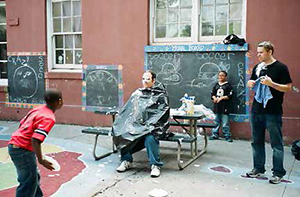
Prior to Geek Week at BCPS, we observed a lock-in event cleverly named Benchmark Madness, after the Arkansas Benchmark tests to be administered in a month’s time. We were surprised when a teacher rolled into a cafeteria full of quietly seated students on a scooter, in his pajamas, complete with matching bathrobe and house shoes, spraying students with Silly String and Nerf gun darts.
Inside and outside the classroom, students are encouraged to work together. That evening, students enjoyed numerous team-building events uniting students, faculty, staff, and parent volunteers. Students participated in a variety of activities. Walking from room to room, students could be seen tie-dyeing shirts, building clay sculptures, singing karaoke, building forts, and attempting to best each other in word games. These activities mostly took place in classrooms or at stations outside, through which small groups of students would rotate. Once students had made complete rotations through the teacher-led activities, the students would return to the cafeteria for an Hour of Power.
The first Hour of Power consisted of students learning song parodies that were focused on strategies and motivation to do well in school and on the upcoming Benchmarks. Students belted out the lyrics of a song titled “Beat That Benchmark Test.” A nonstop dance party held from midnight to 1 a.m. was the second Hour of Power. The final Hour of Power took place at 5 a.m. Using the light of the rising sun, the students followed a few teachers on a morning jog around campus. At the end, other teachers positioned on top of the school buildings bombarded students with water balloons.
While none of these activities seemed to be related to the specific items that students would soon face on the benchmark exam, it was obvious that teamwork and leadership were being developed. Students relied on and supported one another as they traveled from one activity to the next with a great deal of autonomy from their teachers and responsibility for keeping up with all of their group members. In the end, the purposes of Benchmark Madness were to have fun and to motivate students in their battle to dominate standardized tests.
As KIPP Delta director Scott Shirey put it, the state benchmark exam is the enemy that unites students and faculty: “If it didn’t exist, we would have to create it.”
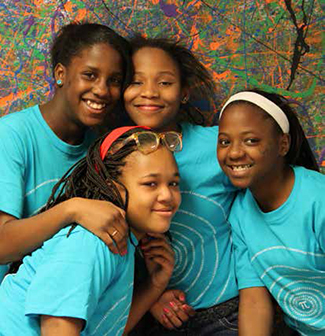
The Takeaways
Of course, these are just a few days in the life of these KIPP schools. Typical times are more mundane. Even so, from what we have seen, KIPP schools are successful high-poverty schools. Teachers and kids have good days and bad days. Many kids have troubled home lives, which make schooling more challenging and require that school staff be flexible and accommodate changing student needs. The toughest times in KIPP schools are when the schools are new and the Work Hard, Be Nice culture is being established. Principals and teachers have to set up the goals of the school clearly and gain student buy-in through constant feedback, both positive and negative. Once basic safety and a college-bound culture are established, KIPPsters and their teachers get down to the daily tasks of teaching and learning. But they can also have fun. There may be more opportunity for fun than at most schools, since KIPP schools seem to have less bullying, no competition over clothes, and students who share the goals of getting ahead academically and helping their peers do the same.
Our extensive fieldwork shows that in contrast to the claims of some KIPP backers, there is no magic. In contrast to the claims of KIPP detractors, there is no ill treatment of children. There is lots of hard work and hard play, led by teachers and administrators who, at most KIPP schools, know every kid and every family. Traditional public schools can copy nearly all of the KIPP playbook, if they wish to try. If doing so establishes a culture of cooperation and academic success among students, teachers, and parents, would that be such a bad thing?
Alexandra M. Boyd is doctoral academy fellow in the department of education reform at the University of Arkansas, where Robert Maranto is professor of education reform. Caleb Rose teaches in a dropout recovery charter school in Little Rock.
This article appeared in the Winter 2014 issue of Education Next. Suggested citation format:
Boyd, A., Maranto, R., and Rose, C. (2014). The Softer Side of “No Excuses” – A view of KIPP schools in action. Education Next, 14(1), 48-53.


